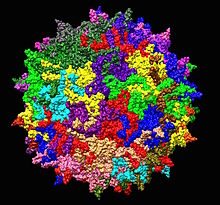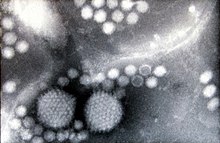腺相關病毒
| 腺相關病毒 | |
|---|---|

| |
| 一種用作人基因治療載體的腺相關病毒1LP3的3D原子結構 | |
| 病毒分類 | |
| (未分級): | 病毒 Virus |
| 域: | 單鏈DNA病毒域 Monodnaviria |
| 界: | 稱德病毒界 Shotokuvirae |
| 門: | 科薩特病毒門 Cossaviricota |
| 綱: | 第五病毒綱 Quintoviricetes |
| 目: | 小病毒目 Piccovirales |
| 科: | 細小病毒科 Parvoviridae |
| 屬: | 依賴性細小病毒屬 Dependoparvovirus |
| 種: | 腺相關病毒 Adeno-associated virus
|
| 種類 | |
| |
腺相關病毒(Adeno-associated viruses,常縮寫為AAV),是一種隸屬細小病毒科依賴性細小病毒屬、能夠感染人類以及其他部分靈長類動物的病毒。腺相關病毒直徑約20納米、無被膜,無法自主完成複製,全基因組長約4.8千鹼基對(kb)[1][2]。
尚無已知的疾病與腺相關病毒有關。腺相關病毒一般只能引發輕度的免疫反應。加之腺相關病毒須在其他病毒同時感染宿主的前提下才能複製,使研究者認為腺相關病毒適合用於改造用作人基因治療的載體,以及體外等基因人類疾病模型的構建[3]。由腺病毒改造而成的基因治療載體能夠同時感染分裂中和分裂不活躍的細胞,並將載體DNA以一種不整合入染色體的方式導入到細胞中(不過在自然條件下,也有腺相關病毒攜帶的DNA在感染後插入染色體的報導)[4]。目前,一部分使用腺相關病毒的基因治療臨床試驗已取得正面的結果[5]。
研究歷史
[編輯]腺相關病毒最初被認為是腺病毒製備過程中混入的污染物之一。20世紀60年代,匹茲堡大學的鮑勃·艾奇遜(Bob Atchison)與美國國立衛生研究院的華萊士·羅(Wallace P. Rowe)實驗室的工作最初確定腺相關病毒是一種依賴性細小病毒。後來的血清學研究表明,腺相關病毒不能造成任何已知的人類疾病,且只能在腺病毒、疱疹病毒等輔助病毒存在的前提下才能感染人類[6]。
複製周期
[編輯]
絕大部分情況下,腺相關病毒需要輔助病毒的存在才能完成完整的生命周期[7]。腺相關病毒在感染細胞後,需要輔助病毒的幫助(例如,腺相關病毒的輔助病毒疱疹病毒能為其提供DNA聚合酶和解旋酶以及一些對腺相關病毒轉錄的早期啟動必要的蛋白)才能進入裂解期,進行病毒複製。在沒有輔助病毒的前提下,腺相關病毒基因的表現將會受限,一部分腺相關病毒DNA會在這種情況下插入至人19號染色體q13.4區域,即AAVS1位點[8]。
基因組
[編輯]
腺相關病毒的基因組由一條長約4.8千鹼基對(kb)的正義或反義單鏈DNA構成,其兩端是序列對稱的反向重複序列(ITR),對腺相關病毒的複製[9]、衣殼化[10]、以及插入宿主染色體的過程有重要作用[11][12] ,中間則有rep與cap兩個開放讀框,前者包括四個序列相互重疊的基因,編碼Rep78、Rep68、Rep52與Rep40等四種參與病毒基因複製的蛋白;後者包括三個序列重疊的基因,編碼VP1、VP2與VP3等三種組成病毒衣殼的蛋白[13]。腺相關病毒本身不編碼DNA聚合酶,僅仰賴宿主細胞或輔助病毒的DNA聚合酶合成自己的基因組[14]。
反向重複序列
[編輯]腺相關病毒基因組兩端的反向重複序列(ITR)序列對稱,長145鹼基,可各自形成一莖環結構,使病毒利用其3'活性端開始DNA複製,無需由引子酶合成引子即可複製自身的DNA[14],形成相互連結的雙股DNA中間產物,再以缺口酶將兩股DNA切開[14]。除DNA複製外,反向重複序列也參與病毒插入宿主DNA的過程[11][12],且為病毒顆粒正常組裝所需[10]。
rep基因
[編輯]腺相關病毒基因組中上游的rep讀框可由左側的p5或p19兩個啟動子開始轉錄,產生長度不一的兩種RNA,這兩種RNA中皆含有一個內含子,可能在轉錄後被切除,依使用啟動子的不同與內含子被切除與否,rep基因可轉錄出四種mRNA,進而產生四種蛋白質變體:Rep78、Rep68、Rep52,以及Rep40(Rep後面的數字代表這種蛋白的分子量為多少千道爾頓)[15],前兩者是由p5啟動子轉錄產生,可與反向重複序列形成的莖環結合,參與病毒DNA的複製,後兩者則是由p19啟動子轉錄產生[16]。四種Rep蛋白皆可與ATP結合,且皆具解旋酶活性,它們可抑制自身的啟動子(p5和p19)轉錄,並可活化轉錄cap基因蛋白的p40啟動子[15][17][18][19][20]。
cap基因
[編輯]cap基因位於rep基因的下游,p40啟動子可調控其轉錄,產生序列重疊的VP1、VP2、VP3與AAP(組裝活化蛋白)四種蛋白,VP1、VP2與VP3的大小分別為87、72與62千道爾頓[21],可以1:1:10的比例組成腺相關病毒二十面體的衣殼[22],AAP亦為衣殼組裝所需的蛋白[23]。cap基因轉錄出的RNA可能將一段較長的內含子或一段較短的內含子切除,分別形成長2.3kb或長2.6kb的mRNA,其中長內含子被切除的情況較為常見,因此2.3kb的mRNA為大宗,可轉譯產生VP3蛋白,但其起始密碼子(AUG)上游有一個ACG密碼子周邊亦形成可起始轉譯的Kozak序列,少數核糖體會自此開始轉譯,產生比VP3蛋白多出一N端延伸區域的VP2蛋白;而切除短內含子的2.6kb的mRNA則會轉譯產生VP1蛋白,也比VP3多了一N端延伸區[24][25][26][27]。
由於2.3mRNA的數量較多,且其上游ACG密碼子啟動轉譯的能力比正常的起始密碼子弱,三種衣殼蛋白中VP3被轉譯生成的量遠多於VP1與VP2,與其在衣殼中的組成比例相符[28]。有研究顯示VP1蛋白的N端延伸區有磷脂酶A2活性,可能有助於病毒自細胞釋出[29],因而為病毒複製週期所需,相較之下VP2可能並非病毒組裝必須的蛋白[30]。
分類
[編輯]腺相關病毒在人類與其他靈長類中相當普遍,目前已知有11個血清型[31],其中AAV-2、AAV-3、AAV-5與AAV-6為自人類細胞發現,AAV-1、AAV-4與AAV-7至AAV-11為自其他靈長類細胞發現[32],其中對AAV-2的研究最多[33][34][35],此血清型可能使用硫酸肝素蛋白多醣(HSPG)、aVβ5整合素與成纖維細胞生長因子受體1(FGFR-1)為受體感染細胞,其中前者為主要受體,後兩者為輔受體,可協助病毒以受質媒介內吞作用進入細胞[36][37][38],但學界對此尚有爭議[39]。
2013年起,國際病毒分類委員會(ICTV)將腺相關病毒分為A型與B型兩個物種,前者包含AAV-1、AAV-2、AAV-3與AAV-4,後者即AAV-5[40][41]。
為提升在腺相關病毒在臨床與研究中作為載體的效率,研究人員研發了許多腺相關病毒的人工變型,以提升基因表現、適應不同的目標組織並使其更易逃避免疫系統的攻擊,例如AAV-2的基因組與AAV-5的衣殼蛋白基因融合組成的AAV-2/5,以及由8型AAV序列融合組成的AAV-DJ 等[42]。
用於基因治療
[編輯]腺相關病毒因毒性低、不能自主複製、不致病,且較少整合到宿主基因組中,因而被認為是一種較為理想的基因治療載體。將腺相關病毒改造為基因治療載體的具體操作方法是腺相關病毒基因組上的rep與cap區域替換為目的基因[3][43]。腺相關病毒載體導入人體後,不分裂的細胞能夠一直保持輸入的目的基因片段,而持續分裂細胞則會逐漸隨細胞分裂丟失經由腺相關病毒導入的基因片段,因此腺相關病毒療法不太適合以持續分裂的細胞(如幹細胞)作為靶標[43]。
腺相關病毒作為基因治療載體存在一些缺點。首先是容量低,最多只能容納4.5kb的插入片段,無法容納DMD等較長的人類基因[43]。其次,輸入的腺相關病毒載體可能被體內存在的針對天然腺相關病毒的抗體中和。此外,腺相關病毒也存在整合入宿主基因組的情況[44]。
過去認為將腺相關病毒用於基因治療時,反向重複序列是病毒基因組中唯一需與轉入的基因順式(in cis)組裝的元件,cap與rep蛋白皆可反式(in trans)導入,但有新研究結果顯示rep基因編碼區域中有一稱為順式rep依賴型元件(cis-acting Rep-dependent element,簡稱CARE)的序列與轉入的基因順式組裝時也可促進病毒的複製與組裝[45][46][47][48]。
根據2019年的資料,全球範圍內共有超過250件使用腺相關病毒載體技術的臨床試驗,占基於病毒載體的基因治療臨床試驗總數的8.3%[49]。
參見
[編輯]參考文獻
[編輯]- ^ Naso, Michael F.; Tomkowicz, Brian; Perry, William L.; Strohl, William R. Adeno-Associated Virus (AAV) as a Vector for Gene Therapy. BioDrugs. 2017, 31 (4): 317–334. ISSN 1173-8804. doi:10.1007/s40259-017-0234-5.
- ^ Wu, Zhijian; Yang, Hongyan; Colosi, Peter. Effect of Genome Size on AAV Vector Packaging. Molecular Therapy. 2010, 18 (1): 80–86. ISSN 1525-0016. doi:10.1038/mt.2009.255.
- ^ 3.0 3.1 Grieger JC, Samulski RJ. Adeno-associated Virus as a Gene Therapy Vector: Vector Development, Production and Clinical Applications. Adeno-associated virus as a gene therapy vector: vector development, production and clinical applications. Advances in Biochemical Engineering/Biotechnology 99. 2005: 119–45. ISBN 978-3-540-28404-8. PMID 16568890. doi:10.1007/10_005.
- ^ Deyle DR, Russell DW. Adeno-associated virus vector integration. Current Opinion in Molecular Therapeutics. August 2009, 11 (4): 442–7. PMC 2929125
 . PMID 19649989.
. PMID 19649989.
- ^ Maguire AM, Simonelli F, Pierce EA, Pugh EN, Mingozzi F, Bennicelli J, et al. Safety and efficacy of gene transfer for Leber's congenital amaurosis. The New England Journal of Medicine. May 2008, 358 (21): 2240–8. PMC 2829748
 . PMID 18441370. doi:10.1056/NEJMoa0802315.
. PMID 18441370. doi:10.1056/NEJMoa0802315.
- ^ Carter BJ. Adeno-associated virus and the development of adeno-associated virus vectors: a historical perspective. Molecular Therapy. 2004, 10 (6): 981–9. PMID 15564130. doi:10.1016/j.ymthe.2004.09.011
 .
.
- ^ Adeno-Associated Virus and Adeno-associated Viral Vectors. [2018-09-19]. (原始內容存檔於2018-09-20).
- ^ Daya, Shyam; Berns, Kenneth I. Gene Therapy Using Adeno-Associated Virus Vectors. Clinical Microbiology Reviews. 2008, 21 (4): 583–593. ISSN 0893-8512. doi:10.1128/CMR.00008-08.
- ^ Bohenzky RA, LeFebvre RB, Berns KI. Sequence and symmetry requirements within the internal palindromic sequences of the adeno-associated virus terminal repeat. Virology. October 1988, 166 (2): 316–27. PMID 2845646. doi:10.1016/0042-6822(88)90502-8.
- ^ 10.0 10.1 Zhou X, Muzyczka N. In vitro packaging of adeno-associated virus DNA. Journal of Virology. April 1998, 72 (4): 3241–7. PMC 109794
 . PMID 9525651. doi:10.1128/JVI.72.4.3241-3247.1998.
. PMID 9525651. doi:10.1128/JVI.72.4.3241-3247.1998.
- ^ 11.0 11.1 Wang XS, Ponnazhagan S, Srivastava A. Rescue and replication signals of the adeno-associated virus 2 genome. Journal of Molecular Biology. July 1995, 250 (5): 573–80. PMID 7623375. doi:10.1006/jmbi.1995.0398.
- ^ 12.0 12.1 Weitzman MD, Kyöstiö SR, Kotin RM, Owens RA. Adeno-associated virus (AAV) Rep proteins mediate complex formation between AAV DNA and its integration site in human DNA. Proceedings of the National Academy of Sciences of the United States of America. June 1994, 91 (13): 5808–12. Bibcode:1994PNAS...91.5808W. PMC 44086
 . PMID 8016070. doi:10.1073/pnas.91.13.5808.
. PMID 8016070. doi:10.1073/pnas.91.13.5808.
- ^ Carter BJ. Adeno-associated virus and adeno-associated virus vectors for gene delivery. Lassic DD, Templeton NS (編). Gene Therapy: Therapeutic Mechanisms and Strategies. New York City: Marcel Dekker, Inc. 2000: 41–59. ISBN 978-0-585-39515-9.
- ^ 14.0 14.1 14.2 Gonçalves MA. Adeno-associated virus: from defective virus to effective vector.. Virol J. 2005, 2: 43. PMC 1131931
 . PMID 15877812. doi:10.1186/1743-422X-2-43.
. PMID 15877812. doi:10.1186/1743-422X-2-43.
- ^ 15.0 15.1 Kyöstiö SR, Owens RA, Weitzman MD, Antoni BA, Chejanovsky N, Carter BJ. Analysis of adeno-associated virus (AAV) wild-type and mutant Rep proteins for their abilities to negatively regulate AAV p5 and p19 mRNA levels. Journal of Virology. May 1994, 68 (5): 2947–57. PMC 236783
 . PMID 8151765. doi:10.1128/JVI.68.5.2947-2957.1994.
. PMID 8151765. doi:10.1128/JVI.68.5.2947-2957.1994.
- ^ Sitaraman V, Hearing P, Ward CB, Gnatenko DV, Wimmer E, Mueller S; et al. Computationally designed adeno-associated virus (AAV) Rep 78 is efficiently maintained within an adenovirus vector.. Proc Natl Acad Sci U S A. 2011, 108 (34): 14294–9. PMC 3161519
 . PMID 21844368. doi:10.1073/pnas.1102883108.
. PMID 21844368. doi:10.1073/pnas.1102883108.
- ^ Im DS, Muzyczka N. The AAV origin binding protein Rep68 is an ATP-dependent site-specific endonuclease with DNA helicase activity. Cell. May 1990, 61 (3): 447–57. PMID 2159383. S2CID 27997617. doi:10.1016/0092-8674(90)90526-K.
- ^ Im DS, Muzyczka N. Partial purification of adeno-associated virus Rep78, Rep52, and Rep40 and their biochemical characterization. Journal of Virology. February 1992, 66 (2): 1119–28. PMC 240816
 . PMID 1309894. doi:10.1128/JVI.66.2.1119-1128.1992.
. PMID 1309894. doi:10.1128/JVI.66.2.1119-1128.1992.
- ^ Samulski RJ. AAV vectors, the future workhorse of human gene therapy. Human Gene Therapy: Current Opportunities and Future Trends. 2003: 25–40. ISBN 978-3-662-05354-6. PMID 12894449. doi:10.1007/978-3-662-05352-2_3.
|journal=被忽略 (幫助);|issue=被忽略 (幫助) - ^ Trempe JP, Carter BJ. Regulation of adeno-associated virus gene expression in 293 cells: control of mRNA abundance and translation. Journal of Virology. January 1988, 62 (1): 68–74. PMC 250502
 . PMID 2824856. doi:10.1128/JVI.62.1.68-74.1988.
. PMID 2824856. doi:10.1128/JVI.62.1.68-74.1988.
- ^ Jay FT, Laughlin CA, Carter BJ. Eukaryotic translational control: adeno-associated virus protein synthesis is affected by a mutation in the adenovirus DNA-binding protein. Proceedings of the National Academy of Sciences of the United States of America. May 1981, 78 (5): 2927–31. Bibcode:1981PNAS...78.2927J. PMC 319472
 . PMID 6265925. doi:10.1073/pnas.78.5.2927.
. PMID 6265925. doi:10.1073/pnas.78.5.2927.
- ^ Sonntag F, Schmidt K, Kleinschmidt JA. A viral assembly factor promotes AAV2 capsid formation in the nucleolus. Proceedings of the National Academy of Sciences of the United States of America. June 2010, 107 (22): 10220–5. Bibcode:2010PNAS..10710220S. PMC 2890453
 . PMID 20479244. doi:10.1073/pnas.1001673107.
. PMID 20479244. doi:10.1073/pnas.1001673107.
- ^ Sonntag F, Köther K, Schmidt K, Weghofer M, Raupp C, Nieto K, Kuck A, Gerlach B, Böttcher B, Müller OJ, Lux K, Hörer M, Kleinschmidt JA. The assembly-activating protein promotes capsid assembly of different adeno-associated virus serotypes. Journal of Virology. December 2011, 85 (23): 12686–97. PMC 3209379
 . PMID 21917944. doi:10.1128/JVI.05359-11.
. PMID 21917944. doi:10.1128/JVI.05359-11.
- ^ Becerra SP, Rose JA, Hardy M, Baroudy BM, Anderson CW. Direct mapping of adeno-associated virus capsid proteins B and C: a possible ACG initiation codon. Proceedings of the National Academy of Sciences of the United States of America. December 1985, 82 (23): 7919–23. Bibcode:1985PNAS...82.7919B. PMC 390881
 . PMID 2999784. doi:10.1073/pnas.82.23.7919.
. PMID 2999784. doi:10.1073/pnas.82.23.7919.
- ^ Cassinotti P, Weitz M, Tratschin JD. Organization of the adeno-associated virus (AAV) capsid gene: mapping of a minor spliced mRNA coding for virus capsid protein 1. Virology. November 1988, 167 (1): 176–84. PMID 2847413. doi:10.1016/0042-6822(88)90067-0.
- ^ Muralidhar S, Becerra SP, Rose JA. Site-directed mutagenesis of adeno-associated virus type 2 structural protein initiation codons: effects on regulation of synthesis and biological activity. Journal of Virology. January 1994, 68 (1): 170–6. PMC 236275
 . PMID 8254726. doi:10.1128/JVI.68.1.170-176.1994.
. PMID 8254726. doi:10.1128/JVI.68.1.170-176.1994.
- ^ Trempe JP, Carter BJ. Alternate mRNA splicing is required for synthesis of adeno-associated virus VP1 capsid protein. Journal of Virology. September 1988, 62 (9): 3356–63. PMC 253458
 . PMID 2841488. doi:10.1128/JVI.62.9.3356-3363.1988.
. PMID 2841488. doi:10.1128/JVI.62.9.3356-3363.1988.
- ^ Rabinowitz JE, Samulski RJ. Building a better vector: the manipulation of AAV virions. Virology. December 2000, 278 (2): 301–8. PMID 11118354. doi:10.1006/viro.2000.0707
 .
.
- ^ Girod A, Wobus CE, Zádori Z, Ried M, Leike K, Tijssen P, Kleinschmidt JA, Hallek M. The VP1 capsid protein of adeno-associated virus type 2 is carrying a phospholipase A2 domain required for virus infectivity. The Journal of General Virology. May 2002, 83 (Pt 5): 973–8. PMID 11961250. doi:10.1099/0022-1317-83-5-973
 .
.
- ^ Warrington KH, Gorbatyuk OS, Harrison JK, Opie SR, Zolotukhin S, Muzyczka N. Adeno-associated virus type 2 VP2 capsid protein is nonessential and can tolerate large peptide insertions at its N terminus. Journal of Virology. June 2004, 78 (12): 6595–609. PMC 416546
 . PMID 15163751. doi:10.1128/JVI.78.12.6595-6609.2004.
. PMID 15163751. doi:10.1128/JVI.78.12.6595-6609.2004.
- ^ Mori S, Wang L, Takeuchi T, Kanda T. Two novel adeno-associated viruses from cynomolgus monkey: pseudotyping characterization of capsid protein. Virology. December 2004, 330 (2): 375–83. PMID 15567432. doi:10.1016/j.virol.2004.10.012
 .
.
- ^ Weitzman, Matthew D.; Linden, R. Michael. Adeno-Associated Virus Biology. Snyder, R. O.; Moullier, P (編). Adeno-associated virus methods and protocols. Totowa, NJ: Humana Press. 2011. ISBN 978-1-61779-370-7.
- ^ Bartlett JS, Samulski RJ, McCown TJ. Selective and rapid uptake of adeno-associated virus type 2 in brain. Human Gene Therapy. May 1998, 9 (8): 1181–6. PMID 9625257. doi:10.1089/hum.1998.9.8-1181.
- ^ Fischer AC, Beck SE, Smith CI, Laube BL, Askin FB, Guggino SE, Adams RJ, Flotte TR, Guggino WB. Successful transgene expression with serial doses of aerosolized rAAV2 vectors in rhesus macaques. Molecular Therapy. December 2003, 8 (6): 918–26. PMID 14664794. doi:10.1016/j.ymthe.2003.08.015
 .
.
- ^ Nicklin SA, Buening H, Dishart KL, de Alwis M, Girod A, Hacker U, Thrasher AJ, Ali RR, Hallek M, Baker AH. Efficient and selective AAV2-mediated gene transfer directed to human vascular endothelial cells. Molecular Therapy. September 2001, 4 (3): 174–81. PMID 11545607. doi:10.1006/mthe.2001.0424
 .
.
- ^ Qing K, Mah C, Hansen J, Zhou S, Dwarki V, Srivastava A. Human fibroblast growth factor receptor 1 is a co-receptor for infection by adeno-associated virus 2. Nature Medicine. January 1999, 5 (1): 71–7. PMID 9883842. S2CID 31602526. doi:10.1038/4758.
- ^ Summerford C, Samulski RJ. Membrane-associated heparan sulfate proteo-glycan is a receptor for adeno-associated virus type 2 virions. Journal of Virology. Feb 1998, 72 (2): 1438–45. PMC 124624
 . PMID 9445046. doi:10.1128/JVI.72.2.1438-1445.1998.
. PMID 9445046. doi:10.1128/JVI.72.2.1438-1445.1998.
- ^ Summerford C, Bartlett JS, Samulski RJ. AlphaVbeta5 integrin: a co-receptor for adeno-associated virus type 2 infection. Nature Medicine. January 1999, 5 (1): 78–82. PMID 9883843. S2CID 23326070. doi:10.1038/4768.
- ^ Qiu J, Handa A, Kirby M, Brown KE. The interaction of heparin sulfate and adeno-associated virus 2. Virology. March 2000, 269 (1): 137–47. PMID 10725206. doi:10.1006/viro.2000.0205
 .
.
- ^ ICTV Taxonomy history: Adeno-associated dependoparvovirus A. ICTV. [31 January 2020]. (原始內容存檔於2021-07-12).
- ^ ICTV Taxonomy history: Adeno-associated dependoparvovirus B. ICTV. [31 January 2020]. (原始內容存檔於2021-07-11).
- ^ Adeno-associated Virus (AAV) Guide. Addgene. [2021-07-10]. (原始內容存檔於2022-10-05).
- ^ 43.0 43.1 43.2 Worgall, Stefan; Crystal, Ronald G. Gene therapy: 493–518. 2020. doi:10.1016/B978-0-12-818422-6.00029-0.
- ^ Shams, Shahin; Silva, Eduardo A. Bioengineering strategies for gene delivery: 107–148. 2020. doi:10.1016/B978-0-12-816221-7.00004-5.
- ^ Nony P, Tessier J, Chadeuf G, Ward P, Giraud A, Dugast M, Linden RM, Moullier P, Salvetti A. Novel cis-acting replication element in the adeno-associated virus type 2 genome is involved in amplification of integrated rep-cap sequences. Journal of Virology. October 2001, 75 (20): 9991–4. PMC 114572
 . PMID 11559833. doi:10.1128/JVI.75.20.9991-9994.2001.
. PMID 11559833. doi:10.1128/JVI.75.20.9991-9994.2001.
- ^ Nony P, Chadeuf G, Tessier J, Moullier P, Salvetti A. Evidence for packaging of rep-cap sequences into adeno-associated virus (AAV) type 2 capsids in the absence of inverted terminal repeats: a model for generation of rep-positive AAV particles. Journal of Virology. January 2003, 77 (1): 776–81. PMC 140600
 . PMID 12477885. doi:10.1128/JVI.77.1.776-781.2003.
. PMID 12477885. doi:10.1128/JVI.77.1.776-781.2003.
- ^ Philpott NJ, Giraud-Wali C, Dupuis C, Gomos J, Hamilton H, Berns KI, Falck-Pedersen E. Efficient integration of recombinant adeno-associated virus DNA vectors requires a p5-rep sequence in cis. Journal of Virology. June 2002, 76 (11): 5411–21. PMC 137060
 . PMID 11991970. doi:10.1128/JVI.76.11.5411-5421.2002.
. PMID 11991970. doi:10.1128/JVI.76.11.5411-5421.2002.
- ^ Tullis GE, Shenk T. Efficient replication of adeno-associated virus type 2 vectors: a cis-acting element outside of the terminal repeats and a minimal size. Journal of Virology. December 2000, 74 (24): 11511–21. PMC 112431
 . PMID 11090148. doi:10.1128/JVI.74.24.11511-11521.2000.
. PMID 11090148. doi:10.1128/JVI.74.24.11511-11521.2000.
- ^ Vectors used in Gene Therapy Clinical Trials. Journal of Gene Medicine. Wiley. December 2019 [2012-01-04]. (原始內容存檔於2019-10-21).
